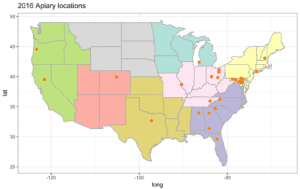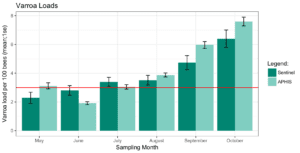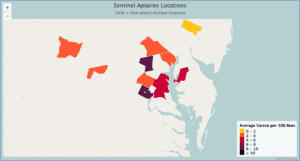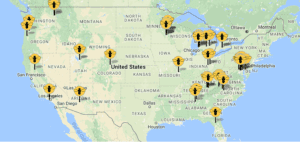With the help of beekeepers all over the country, we have successfully completed our second year of the Sentinel Apiary Program! In 2016, 28 beekeepers from 16 states worked with us. Together we:
- Sampled and monitored the health of 289 colonies
- Processed 1,229 samples for Varroa and Nosema
- Shared data from 32 hive scales
- Collaborated with our beekeeping neighbors to improve colony health in our regions

After compiling over six months of Varroa, Nosema, and colony inspection data, we are excited to share our results (see the complete 2016 Summary Report Here). Below you can compare our Sentinel Apiary Participant’s average monthly Varroa levels to the APHIS National Honey Bee Survey’s national monthly average. We were thrilled to see that Sentinel Participants had significantly lower mites/100 bees in the key winter prep months of September and October; however, more work needs to be done as those samples were still over threshold.


Last year we also developed a new public Sentinel Apiary Varroa heat map. This is the first consolidation of Varroa numbers at the county level! Thanks to Sentinel Apiary Participants, we are now able to keep careful watch over our region, state, and some counties to be prepared for any spikes in Varroa infestations. The more counties we have participate, the more useful this map will be for beekeepers across the nation!
Sentinel Apiaries also include hive scale data collection, and last year we grew to have more scales on the BIP scale map than ever before. Hive scale data can help alert beekeepers when to add or remove supers, when to feed, or if a colony has potentially swarmed. Data collected by Sentinel Apiaries and shared on our public map can thus help not only Sentinel Participants, but all beekeepers in the surrounding region.
 Our live Hive Scale Map can be viewed HERE.
Our live Hive Scale Map can be viewed HERE.
Overview of the Sentinel Apiary Program
Sentinel Apiaries monitor honey bee health in real-time using hive scales to track colony weight gain or loss, and monthly disease assessments of Varroa and Nosema loads. The scale data is automatically transmitted to our servers and the patterns of nectar flow mapped.
The goal is to collect enough information so that Sentinel Apiaries become an early warning system to alert beekeepers of potential problems due to increases in Varroa/Nosema or changes in colony weight. One Sentinel Apiary in a county can thus empower all beekeepers in that area to take early action to protect their colonies.
This is a great opportunity for individual beekeepers and beekeeping organizations alike! As an individual you will gather in-depth knowledge about the health or your colonies and apiary. As an organization, sampling Sentinel Hives offers a unique opportunity to train new beekeepers and to have interactive field days. You will be able to make more informed management decisions, as well as share information with beekeepers in your region to encourage collaborative colony monitoring and management.
This year, we are pleased to offer two new cooperating hive scale vendors, making the Program more affordable than ever! Plus, on a limited first-come first-serve basis, we are able to offer $300 subsidy towards the purchase of a scale for the Program.
Participate in the Sentinel Apiary Project
We are now accepting applications for the 2017 Sentinel Apiary Program. With data collected from Disease Load Monitoring and a Hive Scale, you will gain information you need to take your beekeeping to the next level.
If you are a beekeeping association or an individual beekeeper who is interested in joining our Sentinel Apiary Program, please click the “Sign Up” button below and we will contact you to provide more details about the Sentinel Hives.